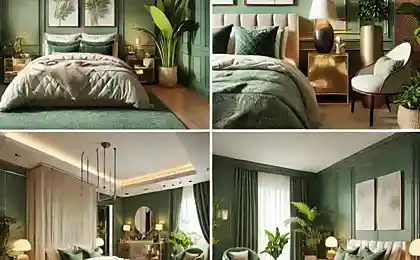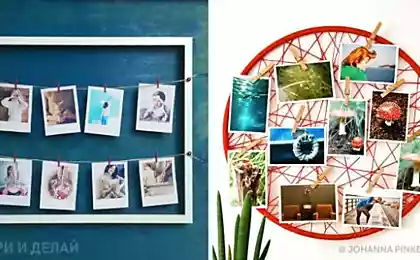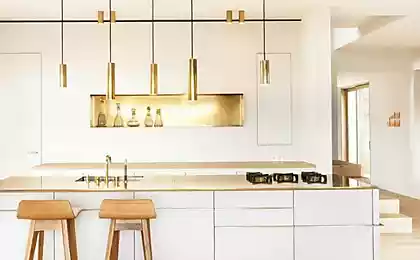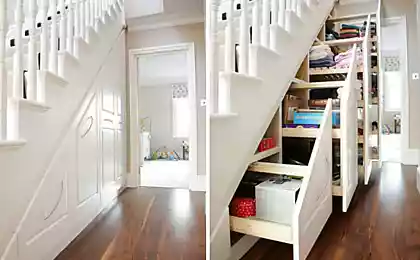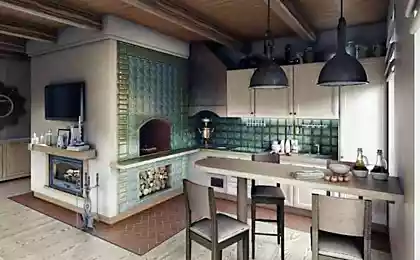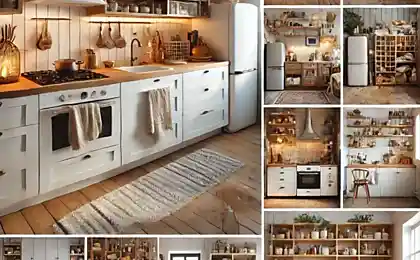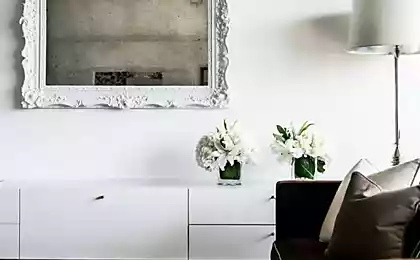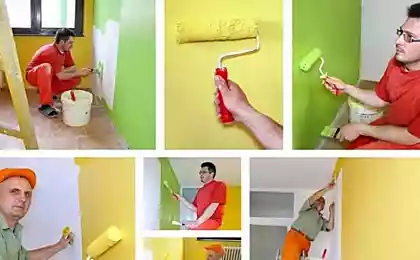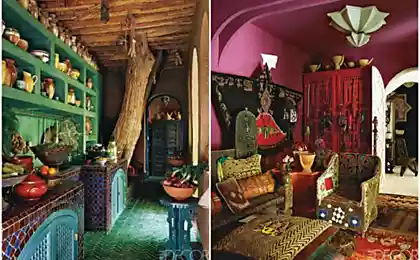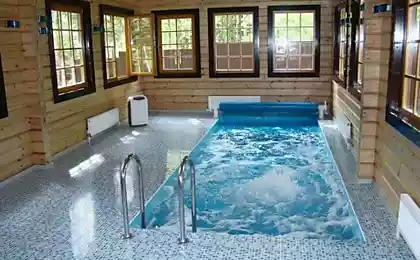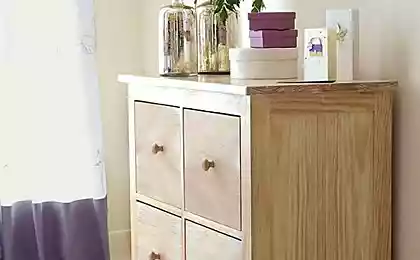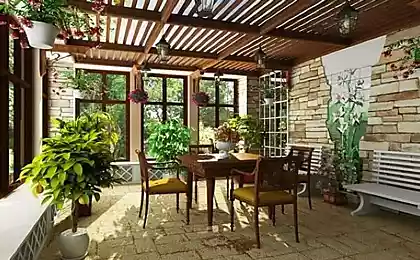215
15 interesting ideas for posting photos in your house
Even the smallest apartment has empty walls, and even the most convinced fan of minimalism from time to time feels the desire to decorate them with something. A reference scheme for posting photos and pictures does not exist, but some rules help to navigate a variety of options. They are followed and violated by apartment owners and designers around the world. And we invite you to be inspired by a selection of interiors published on Houzz and find your own creative path.
1. Sweden: large-scale composition with preliminary preparation
The owners of this 80-meter apartment in Stockholm have long gone to create a spectacular gallery on the living room wall. First, they collected engravings, posters and pictures - they began to think about hanging only when they were convinced that their collection had enough spectacular illustrations. Secondly, we decided to mix different works of art. Third, for a long time experimented with future hanging, laying out the composition on the floor, and chose an asymmetric scenario in which three large images collect around themselves small-format illustrations.
2. Italy: corner option
Corners are a weak spot in many apartments; if you lack storage space and decor, appreciate the joints between the walls - perhaps that's where the extra reserves are hiding.
The owners of this spacious apartment in Milan love vintage graphics. To achieve harmony in the arrangement of the gallery, they selected black and white prints and enclosed them in frames of the same color, but different widths. There is also its own line of symmetry - the junction between the walls, while the collection stretches horizontally in one direction, and on the other takes a strictly allotted place in the wall.
3. Spain: laconic symmetry
The owners of this house keep a fashionable store and love decor with all their heart, and therefore do not hesitate to have some redundancy in the interior. For the composition of the paintings, they chose the traditional method of symmetry, but beat it in a more dynamic way: if you look closely, a group of seven illustrations resembles a bow with the largest element in the center. To avoid visual chaos help modest image size and the same dark frames that harmonize with the shade of furniture in the office.
4. Canada: several levels of shelves
One of the simplest schemes that allows you to harmoniously arrange photos in frames is to organize them on several narrow horizontal shelves. For example, fill a niche or the distance between cabinets.
Photos on the shelves can be placed on the shelves – our heroes from Canada used this technique not only in the living room, but also in the hallway to accommodate the entire huge collection of memorable decor, graphics and family photos.
By the way, this method allows you to quickly change the exposure as soon as you stop paying attention to the images - just reorganize the frames on the shelf: remove some of the old ones, arrange new ones in the frame, rearrange the contents of the upper and lower shelves.
5. France: Creative Negligence
Instead of long and painstakingly adjusting the composition to the ideal, designer Nicolas Perot deliberately hung the paintings in his bedroom unevenly - in his words, this approach emphasizes the connection between movement and life.
6. Italy: frames in frame
Gallery hanging - a museum technique in which images are mounted on fishing lines and organized vertically - is often used in cases where it is not possible to drill walls in ten places. But our heroine from Rome offered an even more original scenario: in her home workshop, fishing lines are stretched right in the space of a large frame, and square-format photographs are organized into two compositions with central elements.
7. Great Britain: Gallery of Memories on Clips
Another life hack for those who do not get along with the drill: organize photos on the principle of garland on the clothespins, following the example of our heroes from London. In the house of a young couple, such a garland hangs on the wall by the stairs and, according to the owners, welcomes guests - in principle, you can find any free space in the apartment for it to save memories only in electronic form, but also in pictures.
8. Netherlands: metal holder for postcards
Such metal or wire structures can be found at the exit of cafes and supermarkets, in bookstores and souvenir shops. It turns out that they can be useful at home, especially if you have a passion for postcards or small-format photos. The pros and cons are obvious: on the one hand, the obvious saving of space, on the other - a strictly limited size of illustrations.
9. U.S.: Take the wall from floor to ceiling
The owner of this Manhattan apartment, producer Bradford Shellhammer, loves visual art objects and admits: As a teenager, I covered the whole room with posters with rock stars. I still fill the walls from floor to ceiling, only now with art.
Well, this strategy can also be adopted if you are not afraid of bold experiments. The obvious advantages of this approach: the collection can be supplemented and modified according to mood, without fear that the scheme will collapse if you remove any fragment from it.
10. France: Around the Central Element
The owners of this 40-meter apartment in Paris hung their collection of comics and humorous graphics in a relatively small space between the doorway and the interior window.
Harmoniously organize illustrations helped the scheme with a large central element, around which collected images of small format, and the alternation of colors frames set the composition unobtrusive dynamics.
11. US: Start on the wall - continue on the dresser
The corner of the living room in this house in Ohio is occupied by a dresser; to give the utilitarian storage system a decorative charm, the hostess decided to place a collection of prints and photographs here. The central element of the composition is a watch with gilded arrows, which is delicately framed by a group of images. Stylistic unity helps to achieve passepart under glass, while visually heavier black frames stand on the dresser, and light ones decorate the wall.
12. Australia: masking the flaws of planning with photos
The idea of placing photos and pictures in frames on the floor owners of houses and apartments are ambiguous: someone is delighted with a non-standard idea, others, on the contrary, consider such a technique mocking.
One thing is clear: this arrangement is ideal for those who rent housing and do not want to drill walls, and also effectively fills empty space and saves storage space on the walls. So that the images do not spoil, it is important to take them under the glass and, of course, regularly wipe the dust that settles on the frames.
13. Russia: a complex symmetry
In some successful compositions, it is difficult to guess symmetry, but a close look will notice that the complex group of images, nevertheless, is focused on the central axis.
In the project of Irina Krasheninnikova, this is a vertical row of two narrow frames: on both sides of it other paired images were placed, only on the left they were led to the bottom of the composition, and on the right to the top. Other decor items on the wall are more concise and do not argue with the foreground.
14. Germany: the principle of repetition
The owner of this apartment in Berlin is sure that the interior should be colorful, give pleasure and allow you not to take yourself too seriously. For the dining room with different size chairs, she chose a large triptych with colored butterflies and placed them in one line. In this repetition there is something of pop art: a rhythmic change of shades will definitely not let you get bored.
5. Britain: over the door
Usually, photos and paintings are advised to be placed at eye level so that they are convenient to look at, but the design world knows more tricky tricks. For example, too high ceilings can be visually lowered if you hang images under the ceiling – above the line of cabinets or doorways. published
Author: Evgenia Nazarova
P.S. And remember, just changing our consumption – together we change the world!
Join us on Facebook, VKontakte, Odnoklassniki
Source: www.houzz.ru/ideabooks/53988233/list/s-mira-po-idee-15-shem-razveski-foto-kotorye-otlichno-rabotayut
1. Sweden: large-scale composition with preliminary preparation
The owners of this 80-meter apartment in Stockholm have long gone to create a spectacular gallery on the living room wall. First, they collected engravings, posters and pictures - they began to think about hanging only when they were convinced that their collection had enough spectacular illustrations. Secondly, we decided to mix different works of art. Third, for a long time experimented with future hanging, laying out the composition on the floor, and chose an asymmetric scenario in which three large images collect around themselves small-format illustrations.
2. Italy: corner option
Corners are a weak spot in many apartments; if you lack storage space and decor, appreciate the joints between the walls - perhaps that's where the extra reserves are hiding.
The owners of this spacious apartment in Milan love vintage graphics. To achieve harmony in the arrangement of the gallery, they selected black and white prints and enclosed them in frames of the same color, but different widths. There is also its own line of symmetry - the junction between the walls, while the collection stretches horizontally in one direction, and on the other takes a strictly allotted place in the wall.
3. Spain: laconic symmetry
The owners of this house keep a fashionable store and love decor with all their heart, and therefore do not hesitate to have some redundancy in the interior. For the composition of the paintings, they chose the traditional method of symmetry, but beat it in a more dynamic way: if you look closely, a group of seven illustrations resembles a bow with the largest element in the center. To avoid visual chaos help modest image size and the same dark frames that harmonize with the shade of furniture in the office.
4. Canada: several levels of shelves
One of the simplest schemes that allows you to harmoniously arrange photos in frames is to organize them on several narrow horizontal shelves. For example, fill a niche or the distance between cabinets.
Photos on the shelves can be placed on the shelves – our heroes from Canada used this technique not only in the living room, but also in the hallway to accommodate the entire huge collection of memorable decor, graphics and family photos.
By the way, this method allows you to quickly change the exposure as soon as you stop paying attention to the images - just reorganize the frames on the shelf: remove some of the old ones, arrange new ones in the frame, rearrange the contents of the upper and lower shelves.
5. France: Creative Negligence
Instead of long and painstakingly adjusting the composition to the ideal, designer Nicolas Perot deliberately hung the paintings in his bedroom unevenly - in his words, this approach emphasizes the connection between movement and life.
6. Italy: frames in frame
Gallery hanging - a museum technique in which images are mounted on fishing lines and organized vertically - is often used in cases where it is not possible to drill walls in ten places. But our heroine from Rome offered an even more original scenario: in her home workshop, fishing lines are stretched right in the space of a large frame, and square-format photographs are organized into two compositions with central elements.
7. Great Britain: Gallery of Memories on Clips
Another life hack for those who do not get along with the drill: organize photos on the principle of garland on the clothespins, following the example of our heroes from London. In the house of a young couple, such a garland hangs on the wall by the stairs and, according to the owners, welcomes guests - in principle, you can find any free space in the apartment for it to save memories only in electronic form, but also in pictures.
8. Netherlands: metal holder for postcards
Such metal or wire structures can be found at the exit of cafes and supermarkets, in bookstores and souvenir shops. It turns out that they can be useful at home, especially if you have a passion for postcards or small-format photos. The pros and cons are obvious: on the one hand, the obvious saving of space, on the other - a strictly limited size of illustrations.
9. U.S.: Take the wall from floor to ceiling
The owner of this Manhattan apartment, producer Bradford Shellhammer, loves visual art objects and admits: As a teenager, I covered the whole room with posters with rock stars. I still fill the walls from floor to ceiling, only now with art.
Well, this strategy can also be adopted if you are not afraid of bold experiments. The obvious advantages of this approach: the collection can be supplemented and modified according to mood, without fear that the scheme will collapse if you remove any fragment from it.
10. France: Around the Central Element
The owners of this 40-meter apartment in Paris hung their collection of comics and humorous graphics in a relatively small space between the doorway and the interior window.
Harmoniously organize illustrations helped the scheme with a large central element, around which collected images of small format, and the alternation of colors frames set the composition unobtrusive dynamics.
11. US: Start on the wall - continue on the dresser
The corner of the living room in this house in Ohio is occupied by a dresser; to give the utilitarian storage system a decorative charm, the hostess decided to place a collection of prints and photographs here. The central element of the composition is a watch with gilded arrows, which is delicately framed by a group of images. Stylistic unity helps to achieve passepart under glass, while visually heavier black frames stand on the dresser, and light ones decorate the wall.
12. Australia: masking the flaws of planning with photos
The idea of placing photos and pictures in frames on the floor owners of houses and apartments are ambiguous: someone is delighted with a non-standard idea, others, on the contrary, consider such a technique mocking.
One thing is clear: this arrangement is ideal for those who rent housing and do not want to drill walls, and also effectively fills empty space and saves storage space on the walls. So that the images do not spoil, it is important to take them under the glass and, of course, regularly wipe the dust that settles on the frames.
13. Russia: a complex symmetry
In some successful compositions, it is difficult to guess symmetry, but a close look will notice that the complex group of images, nevertheless, is focused on the central axis.
In the project of Irina Krasheninnikova, this is a vertical row of two narrow frames: on both sides of it other paired images were placed, only on the left they were led to the bottom of the composition, and on the right to the top. Other decor items on the wall are more concise and do not argue with the foreground.
14. Germany: the principle of repetition
The owner of this apartment in Berlin is sure that the interior should be colorful, give pleasure and allow you not to take yourself too seriously. For the dining room with different size chairs, she chose a large triptych with colored butterflies and placed them in one line. In this repetition there is something of pop art: a rhythmic change of shades will definitely not let you get bored.
5. Britain: over the door
Usually, photos and paintings are advised to be placed at eye level so that they are convenient to look at, but the design world knows more tricky tricks. For example, too high ceilings can be visually lowered if you hang images under the ceiling – above the line of cabinets or doorways. published
Author: Evgenia Nazarova
P.S. And remember, just changing our consumption – together we change the world!
Join us on Facebook, VKontakte, Odnoklassniki
Source: www.houzz.ru/ideabooks/53988233/list/s-mira-po-idee-15-shem-razveski-foto-kotorye-otlichno-rabotayut



